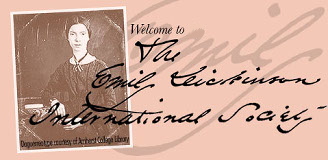

You are hereDunning, Kate: "The Ecopoetics of Emily Dickinson Kate Dunning, Case Western Reserve University"
Submitted by RFranz on July 18, 2013 - 5:50pm
The Ecopoetics of Emily DickinsonKate Dunning, Case Western Reserve University Emily Dickinson was not an ecopoet. At least she was not by influential ecocritic Leonard M. Scigaj’s standards, which require a conscious intention on the part of the author; and yet, the relevance of ecocriticism to the study of Emily Dickinson’s poetry has become increasingly clear since Christine Gerhardt’s 2006 publication “‘Often seen - but seldom felt’: Emily Dickinson’s Reluctant Ecology of Place,” which was one of the first publications to link Dickinson and ecocriticism. For Gerhardt, “Ecocriticism provides an ideally suited conceptual angle from which to examine the links between Dickinson’s explorations of place and nineteenth-century environmental debates,” showing that, “An ecocritical analysis underscores that Dickinson’s poetry, for all its elusiveness and supreme mastery of metaphor, also perceives human-nonhuman relationships as specific to particular locations.” Gerhardt’s article sets the stage for an even broader consideration of the relationship between Emily Dickinson and ecocriticism. My exploration of Dickinson’s engagement with nature draws heavily on the criteria Scigaj uses to differentiate between his categories of nature poetry, environmental poetry, and ecopoetry, each of which forms a subcategory of the one before it. A consideration of a number of Dickinson’s ‘nature poems’ reveals that Dickinson, at different moments, appears to fall into each of Scigaj’s poetic categories; and, moreover, that her poetry displays nearly all of the qualities characteristic of contemporary ecopoetry. At the same time, Dickinson does not display the authorial intentionality or conscious awareness Scigaj requires in order to be considered an ‘ecopoet.’ For these reasons, while I maintain my earlier assertion that Dickinson was not an ecopoet, I argue that her poetry does exhibit a distinctive ecopoetics that allows us to consider not only how her poems engage with the environmental thinking and writing of her day, but also how her work engages current discussions about human interaction with the environment, an understanding of which will allow contemporary readers to consider not only the historical and aesthetic benefits of reading Dickinson’s poems, but the contemporary environmental practicality as well.
|